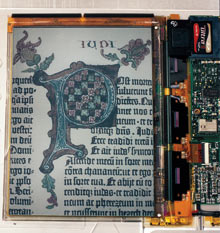E-Paper, In Living Color
Gadgets like the Sony Reader and the newer Amazon Kindle let people read downloaded e-books on crisp displays that are clear even in bright sunlight. But while the devices reproduce the experience of reading ink on paper, they’re rigid, monochrome, and relatively slow to switch pages. Laboratory advances from E Ink of Cambridge, MA, whose technology is used in both e-readers, are pushing electronic-paper technology into color and video.

E Ink’s existing displays feature microcapsules filled with charged black and white chips in a clear liquid. Switching the polarity of an electrode pushes the black or white chips up or down, forming words and images. Thanks to new “inks” it has developed that reflect 47 percent of ambient light (up from 35 to 40 percent), the company was recently able to add red, green, and blue filters to the capsules (below image), producing a prototype color display (top left). Meanwhile, tweaks to the particles, solution, and electronics have boosted the refresh rate from one frame per second in current displays to 30 frames per second in a “video ink” prototype. E Ink is working with partners to develop flexible transistors for use in color displays; eventually, such displays could even roll up. Commercialization is still a few years off, but “you can imagine a USA Today weather chart where clouds are actually moving,” says Russ Wilcox, CEO of E Ink.

Courtesy of E-Ink
Keep Reading
Most Popular
Large language models can do jaw-dropping things. But nobody knows exactly why.
And that's a problem. Figuring it out is one of the biggest scientific puzzles of our time and a crucial step towards controlling more powerful future models.
The problem with plug-in hybrids? Their drivers.
Plug-in hybrids are often sold as a transition to EVs, but new data from Europe shows we’re still underestimating the emissions they produce.
Google DeepMind’s new generative model makes Super Mario–like games from scratch
Genie learns how to control games by watching hours and hours of video. It could help train next-gen robots too.
How scientists traced a mysterious covid case back to six toilets
When wastewater surveillance turns into a hunt for a single infected individual, the ethics get tricky.
Stay connected
Get the latest updates from
MIT Technology Review
Discover special offers, top stories, upcoming events, and more.